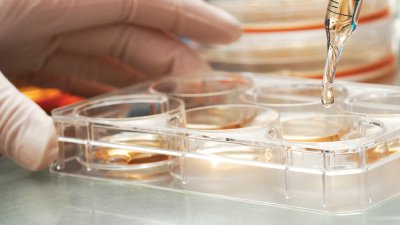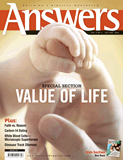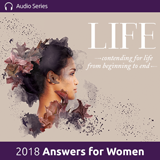
The Home Stretch: 33 Weeks in the Life of an Unborn Baby
How the unborn baby develops in the last stage of pregnancy, is protected by the mother’s immune system, and is nourished by the placenta until birth
Resources to Help You Share the Sanctity-of-Life Message
- Share your story, read inspiring testimonies, get answers, and get help.
- Get a life-affirming VBS for your church and neighborhood.
- Have an eye-catching, “3D” lenticular version of the powerful Fearfully and Wonderfully Made exhibit for your coffee table or church.
- Find out about the Fearfully and Wonderfully Made exhibit at the Creation Museum.
It’s the eighth month of pregnancy, and full-term is so close—and yet so far away for Mom! With just one month to go before she’s considered “early full-term” (at 37 weeks gestational age), Mom is probably very ready to meet the little one she’s been nurturing in her womb. But, while Baby has a 99% chance of survival with proper medical interventions if born now, Baby still has work to do before he or she is fully ready for his or her great debut into the outside world.
Practicing for Life After Birth
At this stage of development, Baby is closing in on his or her birth length, measuring in around 17.2 inches (43 cm), or about the length of a celery stalk, a butternut squash, or cotton candy. The real work is packing on the weight. At only around 4.2 pounds (1.9 kg), Baby will start putting on about half a pound a week between now and delivery.
But Baby has work to do beyond just packing on the pounds. For eight months the baby’s first organ, the placenta, has been doing everything for Baby but the placenta will begin to break down around 42 weeks, so Baby needs to prepare for delivery in just a few weeks and, with delivery, life apart from the placenta. That includes practicing sucking and swallowing in preparation for breast or bottle feeding. The amniotic fluid cushioning the baby is perfect for practicing with, and Baby will drink around a pint a day (and urinate), preparing themselves for feeding as well as getting the gastrointestinal system ready. Baby’s also mastering the “rooting reflex” to find nourishment, turning the head and opening the mouth in response to a touch on the cheek.
Baby’s bones are softer than adults’ and the plates of bone in the skull remain unfused, allowing the baby to squeeze through the birth canal in a few weeks. The baby can now differentiate between day and night, closing his or her eyes when sleeping and opening them when awake.

Model from the Creation Museum’s Fearfully and Wonderfully Made exhibit and book.
The Immune System Develops
Baby has now hit an important developmental milestone—he or she has an immune system as antibodies from Mom pass along to the baby, with more antibodies still to come as Baby continues to develop in the womb. And it doesn’t end with reaching term!1
During a vaginal delivery, healthy bacteria from Mom’s microbiome coat the baby, adding to his or her immune system and populating the gut with the beginnings of their own microbiome.
During a vaginal delivery, healthy bacteria from Mom’s microbiome coat the baby, adding to his or her immune system and populating the gut with the beginnings of their own microbiome. This is why many health care providers now recommend delaying the first bath by 6–20 hours to allow the bacteria time to “get established” (this might sound gross but it’s important for Baby!).
And, if Mom breastfeeds her baby, the baby receives even more antibodies, protecting him or her in the non-sterile environment outside the womb. God truly thought of everything to protect life in a world that’s broken, and now suffers from sickness and disease, from our sin.
The One-Pound Wonder
As I mentioned earlier, the placenta is the baby’s lifeline until birth. This one pound, 8–9-inch disk-shaped organ functions as your baby’s lungs, kidneys, liver, digestive tract, immune system, and endocrine gland.
The placenta is the first organ the baby develops. At fertilization, the sperm from the father and the egg cell from the mother come together, instantly creating a brand-new person, made in God’s image. That fertilized egg then divides into two cells; one becomes the placenta and the other is the baby. And, right away, that developing placenta gets to work.
Before Mom even knows there’s a baby inside her, the developing placenta begins producing hormones to alert the body that the lining of the uterus (the endometrium) needs to be ready for a baby to implant. Sadly, at this stage of development, many women may have taken a “morning-after” pill (e.g. Plan B), which, among other things, can alter the endometrium to make it inhospitable to this new little life, often resulting in the death of the developing baby.
Around day five of life, the developing placental cells fuse together, creating one cell (the syncytial trophoblast) that then “invades” the wall of the uterus, implanting the baby in the womb. But the placenta is not part of the mother’s body—it’s created by the baby and contains the baby’s DNA. How it can implant into the mother’s body without being attacked by her immune system is still rather a mystery, but knowing this completely defeats the “my body, my choice” argument—the baby is not an extension of mother’s body but, rather, is a genetically distinct and utterly unique person who must be protected from Mom’s immune system by the amazing placenta.
As the placenta implants, it penetrates the walls of various uterine veins and arteries, bringing Mom’s life-giving blood into close contact with Baby’s blood (once Baby has developed a circulatory system). This “remodels” Mom’s arteries and blood vessels “from a high-resistance system—high pressure with firm, muscular walls—to a low-resistance system in order to facilitate blood flow from the mother to the placenta.”2
Since the entire surface of the placenta is covered in one giant, seamless cell (about 100 square feet in size!), the mom’s blood never mixes with baby’s blood. Rather, the placenta filters nutrients, gases, hormones, electrolytes, and antibodies from Mom’s blood for Baby and filters waste products from Baby’s blood for Mom to get rid of.
Throughout the pregnancy, the placenta continues to send Mom hormonal signals that let her body know what to do to maintain a healthy pregnancy and even when to prepare for breastfeeding.3 Once the placenta is delivered, Mom’s body knows it’s time to ramp up the milk production because Baby is here and hungry for nutrient-packed colostrum (the first milk) and, within a few days, full-fledged breastmilk.
What an incredible organ!
“They Thought of Everything!”
During one video describing how incredible the entire process of growing a baby is, one labor nurse ended her video by stating something like this, “Whoever is responsible for this process—well, it’s incredible and so amazing. They thought of everything!”
As I prepare for the birth of my fourth baby (I am currently 31 weeks pregnant), I have been watching pregnancy, delivery, and post-partum videos on YouTube. During one video describing how incredible the entire process of growing a baby is, one labor nurse ended her video by stating something like this, “Whoever is responsible for this process—well, it’s incredible and so amazing. They thought of everything!” She was so close to acknowledging the truth of the Creator and yet merely gave the credit to some nebulous “someone” out there. But the entire process of developing a baby is so complex it speaks to the truth of what God’s Word says about it:
For you formed my inward parts;
you knitted me together in my mother's womb.
I praise you, for I am fearfully and wonderfully made.
Wonderful are your works;
my soul knows it very well.
My frame was not hidden from you,
when I was being made in secret,
intricately woven in the depths of the earth.
Your eyes saw my unformed substance;
in your book were written, every one of them,
the days that were formed for me,
when as yet there was none of them. (Psalm 139:13–16)
Footnotes
- Lars A. Hanson et al., “The Transfer of Immunity from Mother to Child,” Ann N Y Acad Sci 987 (April 2003): 199–206, https://doi.org/10.1111/j.1749-6632.2003.tb06049.x.
- Nicole Levine, “Five Things We Know About the Placenta—and a Few We Wish We Did,” Cedars Sinai, February 12, 2021, https://www.cedars-sinai.org/discoveries/placenta.html.
- Liat Ben-Senior, “10 Amazing Facts About the Placenta,” Parent’s Guide to Cord Blood, October 2020, https://parentsguidecordblood.org/en/news/10-amazing-facts-about-placenta.
Recommended Resources

Answers in Genesis is an apologetics ministry, dedicated to helping Christians defend their faith and proclaim the good news of Jesus Christ.
- Customer Service 800.778.3390
- © 2024 Answers in Genesis







